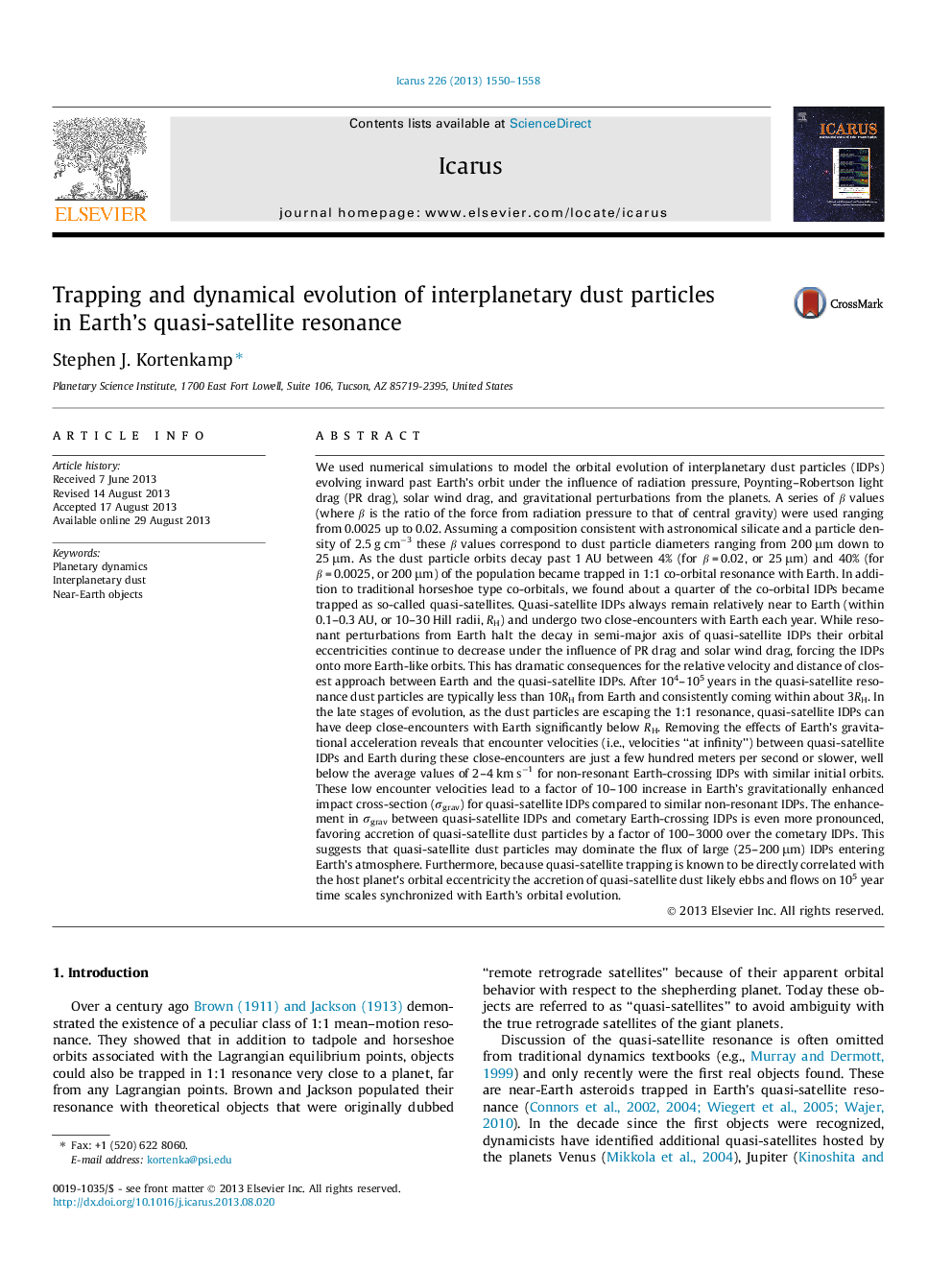| کد مقاله | کد نشریه | سال انتشار | مقاله انگلیسی | نسخه تمام متن |
|---|---|---|---|---|
| 10701399 | 1021129 | 2013 | 9 صفحه PDF | دانلود رایگان |
عنوان انگلیسی مقاله ISI
Trapping and dynamical evolution of interplanetary dust particles in Earth's quasi-satellite resonance
ترجمه فارسی عنوان
تله و تکامل دینامیکی ذرات بین ذرات گرد و غبار در رزونانس شبه ماهواره ای زمین
دانلود مقاله + سفارش ترجمه
دانلود مقاله ISI انگلیسی
رایگان برای ایرانیان
کلمات کلیدی
دینامیک سیاره ای، گرد و غبار بین پلاتین، اشیاء نزدیک به زمین،
موضوعات مرتبط
مهندسی و علوم پایه
علوم زمین و سیارات
علوم فضا و نجوم
چکیده انگلیسی
We used numerical simulations to model the orbital evolution of interplanetary dust particles (IDPs) evolving inward past Earth's orbit under the influence of radiation pressure, Poynting-Robertson light drag (PR drag), solar wind drag, and gravitational perturbations from the planets. A series of β values (where β is the ratio of the force from radiation pressure to that of central gravity) were used ranging from 0.0025 up to 0.02. Assuming a composition consistent with astronomical silicate and a particle density of 2.5 g cmâ3 these β values correspond to dust particle diameters ranging from 200 μm down to 25 μm. As the dust particle orbits decay past 1 AU between 4% (for β = 0.02, or 25 μm) and 40% (for β = 0.0025, or 200 μm) of the population became trapped in 1:1 co-orbital resonance with Earth. In addition to traditional horseshoe type co-orbitals, we found about a quarter of the co-orbital IDPs became trapped as so-called quasi-satellites. Quasi-satellite IDPs always remain relatively near to Earth (within 0.1-0.3 AU, or 10-30 Hill radii, RH) and undergo two close-encounters with Earth each year. While resonant perturbations from Earth halt the decay in semi-major axis of quasi-satellite IDPs their orbital eccentricities continue to decrease under the influence of PR drag and solar wind drag, forcing the IDPs onto more Earth-like orbits. This has dramatic consequences for the relative velocity and distance of closest approach between Earth and the quasi-satellite IDPs. After 104-105 years in the quasi-satellite resonance dust particles are typically less than 10RH from Earth and consistently coming within about 3RH. In the late stages of evolution, as the dust particles are escaping the 1:1 resonance, quasi-satellite IDPs can have deep close-encounters with Earth significantly below RH. Removing the effects of Earth's gravitational acceleration reveals that encounter velocities (i.e., velocities “at infinity”) between quasi-satellite IDPs and Earth during these close-encounters are just a few hundred meters per second or slower, well below the average values of 2-4 km sâ1 for non-resonant Earth-crossing IDPs with similar initial orbits. These low encounter velocities lead to a factor of 10-100 increase in Earth's gravitationally enhanced impact cross-section (Ïgrav) for quasi-satellite IDPs compared to similar non-resonant IDPs. The enhancement in Ïgrav between quasi-satellite IDPs and cometary Earth-crossing IDPs is even more pronounced, favoring accretion of quasi-satellite dust particles by a factor of 100-3000 over the cometary IDPs. This suggests that quasi-satellite dust particles may dominate the flux of large (25-200 μm) IDPs entering Earth's atmosphere. Furthermore, because quasi-satellite trapping is known to be directly correlated with the host planet's orbital eccentricity the accretion of quasi-satellite dust likely ebbs and flows on 105 year time scales synchronized with Earth's orbital evolution.
ناشر
Database: Elsevier - ScienceDirect (ساینس دایرکت)
Journal: Icarus - Volume 226, Issue 2, NovemberâDecember 2013, Pages 1550-1558
Journal: Icarus - Volume 226, Issue 2, NovemberâDecember 2013, Pages 1550-1558
نویسندگان
Stephen J. Kortenkamp,
